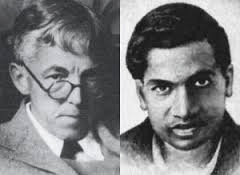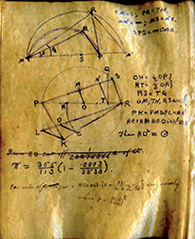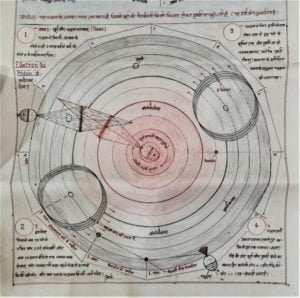The story of mathematical genius S. Ramanujan

His father was K. Srinivasa Iyengar, an accounting clerk for clothing merchant. His mother was Komalatammal, who earned a small amount of money each month as a singer at the local temple of town Kumbakonam. Ramanujan mother thought him Brahmin traditions and culture. His family was high caste Brahmin, but they were very poor. Ramanujan’s parents moved around a lot, and he attended a variety of different elementary schools. By the age of 10, Ramanujan topped in his district Kumbakonam. In the story of mathematical genius S.Ramanujan, an incident happen when he was 15 years old, he finds a book in pure mathematics by George S. Carr from his school library.
Srinivasa Ramanujan education
Ramanujan verified the results in Carr’s book and went beyond it with developing his own theorems and ideas. When he was 12 years old, he had begun the study of calculus. During school days he worked on arithmetic and geometric series and cubic equations. He discovered his own method of solving quartic equations. In 1903 he secured a scholarship from the University of Madras but Ramanujan could not qualify his non-mathematical exams and lost his scholarship. During the year 1905, he traveled to the city of Madras (presently known as Chennai) and enrolled himself at Pachaiyappa’s College. But he again could not qualify his non-mathematical exams. Better we should say education system remains to fail to judge the knowledge of Ramanujan. The mathematics he was doing was original and highly advanced. Even though he had the very little formal higher mathematical education he was able to discover new theorems. He independently finds out the results originally discovered by some of the great mathematicians in history, such as Gauss, Euler Riemann.

Ramanujan continued his work, in the poorest circumstances. Ramanujan married S. Janaki Ammal in1909. After marrying he started to search for a job. He gave an interview with a government official, Ramachandra Rao. Ramachandra Rao was very impressed by Ramanujan and he wants support to his research for a time, but Ramanujan, unwilling to exist on charity. So he helped him obtained a clerical post with the Madras Port Trust. In 1911 Ramanujan published the first of his papers in the Journal of the Indian Mathematical Society. Ramanujan’s knowledge of mathematics (most of which he had worked out for himself) was astonished. He was almost completely unaware of modern developments in mathematics, but his mastery of continued fractions was unequaled by any living mathematician.

Srinivasa Ramanujan contribution to mathematics
He discovers a new theory of divergent series and he also worked out the Riemann series, the elliptic integrals, hypergeometric series and the functional equations of the zeta function. He amazed classmates with his ability to recite the values of irrational numbers like π, e, and √2 to as many decimal places as they asked for. His memory for memorizing mathematical formulas and constants was very good. Ramanujan wrote letters to a number of British professors, but only one of them respond – he was G. H. Hardy pure mathematician at the University of Cambridge, who received a letter from S.Ramanujan in January 1913. By this time, Ramanujan was 25 years old. Professor Hardy puzzled over the nine pages of mathematical notes Ramanujan had sent. They seemed rather incredible. Could it be that one of his colleagues was playing a trick on him? Hardy reviewed the letters with J. E. Littlewood, another Cambridge mathematician. He was telling to Littlewood they had been written by either a crank or a genius, but he wasn’t quite sure which. After spending two and a half hours poring over the outlandishly original work, the mathematicians came to a conclusion. They were looking at the papers of some mathematical genius.
The story of mathematical genius S. Ramanujan: Some of the Ramanujan theorems have no proof that’s why they are known as “Ramanujan Conjectures”. Hardy was eager for Ramanujan to move to Cambridge, but in accordance with his Brahmin beliefs, Ramanujan refused to travel overseas. Instead, an arrangement was made to fund two years of work at the University of Madras. During this time, Ramanujan’s mother had a dream in which the goddess Namagiri told her she should give her son permission to go to Cambridge, and this she did. Ramanujan began work with Hardy and Littlewood during world war first because Ramanujan arrived in Cambridge in April 1914, three months before the outbreak of World War 1. Two years later, he was awarded the equivalent of a Ph.D. in Cambridge University for his work. When Ramanujan left to study at the University of Cambridge, his wife moved in with Ramanujan’s parents. In England Ramanujan research very advanced. His papers were published in English and European journals, and in 1918 he was elected to the Royal Society of London. In 1917 he was diagnosed with tuberculosis and worryingly low weight.
Srinivasa Ramanujan death
In February 1919 he returned to India and his health seemed to recover sufficiently. But sadly he died within a year on his return. The reason behind the illness of Ramanujan was a deficiency of vitamin levels due to the irregular diet. He spent several months in nursing homes in London. He recognized by mathematicians as a phenomenal genius, without peer since Leonhard Euler (1707–83) and Carl Jacobi (1804–51). Like Riemann, Jacobi, Gauss, Euler, Srinivasa Ramanujan also died in early aged 32 in Madras on April 26, 1920. Ramanujan was very shy, quiet and a dignified man with pleasant manners. He lived for a very short interval of life at Cambridge. Ramanujan was rigorously orthodox Hindu Brahmin. He credited his acumen to his family goddess, Mahalakshmi of Namakkal. Goddess Namakkal is the wife of Lord Narashimha (Incarnation of Lord Vishnu). Ramanujan looked to Goddess for inspiration in his work.
The story of mathematical genius S. Ramanujan:

Actually, Ramanujan and his family members were Vaishnav and his mother gave the name to Ramanujan from a Vaishnav saint Ramanujacharya. He often said, “An equation for me has no meaning unless it represents a thought of God.” Hardy cites Ramanujan as remarking that all religions seemed equally true to him. he remarked that Ramanujan was strict pure vegetarian. Ramanujan left behind three notebooks and a sheaf of pages (also called the “lost notebook”) containing many unpublished results that mathematicians continued to verify long after his death. Ramanujan’s prodigious mathematical output amazed Hardy and Littlewood and many more other mathematicians. The lost notebooks of Ramanujan which he had brought from India were filled with thousands of mathematical identities, equations, and theorems which he had discovered for himself in the school days and in years 1903 – 1914.



